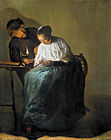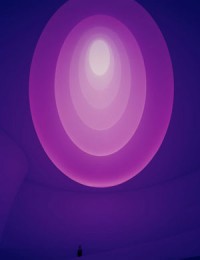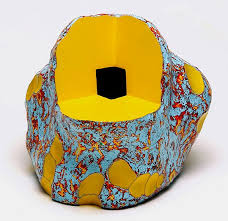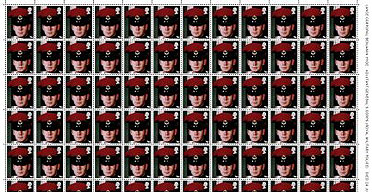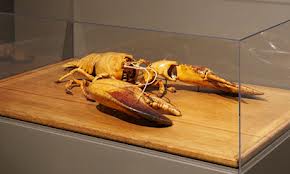by Cynthia Kukla
Twenty years ago, in 1993, the Frans Hals Museum mounted an exhibition of the dozen authentic oil paintings of the ‘lost’ Judith Leyster (1609-1660). Banners throughout the city of Amsterdam proclaimed and celebrated this centennial of Leyster’s rediscovery. Why was this significant? Judith Leyster was a member of the guild of painters in Amsterdam along with Rembrandt and many notable northern European masters. It was a triumph for a woman to be so skilled and to be recognized as a professional artist and guild member. Judith Leyster was the most famous woman painter of the Dutch golden age, the only female member of the painter’s guild known to have had a workshop, and the sole woman artist whose paintings sold in the open market, which was a relatively new form of art patronage in the evolving modern Dutch art world.
Why was she lost? The 1993 exhibition had a long display case with the guild’s records and at a certain point Judith Leyster’s name was omitted from the records. Why? A shortage of vellum?
We cannot know how this omission occurred, but this sad omission matches other acts of marginalization for professional women of past ages. Unscrupulous picture sellers forged Frans Hals signature onto her paintings which, ah, we can then surmise were as good as his.
I vividly retain a special emotional impact of having seen the stunning portraits and figural tableaux of Leyster at the museum (this also against prevailing views that women – like Rachel Ruysch and Marie van Oosterwijk – only painted flowers) and in witnessing the logbooks of the guild, seeing when her name was dropped as a member, for good, almost forever. So I began compiling my own record book of important artists on this twentieth anniversary of the centenary of her rediscovery, of her recovery from obscurity. Inspired by reflecting on this anniversary of Leyster’s re-emergence, I am putting in your ideas, like other critics in America. It has been a remarkable year for the following artists and I proclaim “The Year of” for these deserving artists.
It is “The Year of James Turrell.” No one can come close to Turrell for his magic making. Even when you immerse yourself in the optical, colored glow of his serene evocations of the phenomena of light and perception, you still are not sure where you are or what you are seeing but you are certainly in a state of peace, wonderment and bliss. In a time of loud art, Turrell gives you near-mythic silence. In a time of downloads, scanned miscellany and Epson printer crud, he offers up the sublime. His career spans five-decades and it is fitting three major museum exhibitions gives us a chance to experience his work. “James Turrell: A Retrospective” opened at the Los Angeles County Museum of Art and travels to the Israel Museum in Jerusalem from June 1-Oct. 18, 2014 and the National Gallery of Australia in Canberra from December 2014-April 2015. “James Turrell: The Light Inside” was featured at the Museum of Fine Arts, Houston. It was titled after the museum’s iconic James Turrell permanent installation “The Light Inside” of 1999. The Houston exhibit included works by Turrell they own, which makes more of the artist’s installations accessible to the public for the first time. I reviewed Turrell for Aeqai in my “Letter from LA” in 2012, covering Phenomenal: California Light, Space, Surface at the Museum of Contemporary Art San Diego (MCASD.)
Two round out James Turrell’s stellar year, New York’s Guggenheim Museum commissioned Turrell to create a major new project that, from their press: “recasts the Guggenheim rotunda as an enormous volume filled with shifting natural and artificial light. One of the most dramatic transformations of the museum ever conceived, the installation reimagines Frank Lloyd Wright’s iconic architecture—its openness to nature, graceful curves, and magnificent sense of space—as one of Turrell’s Skyspaces, referencing in particular his magnum opus the Roden Crater Project (1979– ). Reorienting visitors’ experiences of the rotunda from above to below, Aten Reign gives form to the air and light occupying the museum’s central void, proposing an entirely new experience of the building.” The Guggenheim exhibition was strikingly reviewed earlier in 2013 in Aeqai. Many among us art lovers dream of going to Roden Crater in person and surely it is regarded as one of the greatest art works made by a contemporary artist.
It is “The Year of Ken Price.” It is no easy task to make a lifetime body of work in ceramics that captures the collective attention of the art world and fitting that Ken Price did enjoy some of this special recognition before he died in 2012; his work was superbly received in the “Pacific Standard Time” survey of West Coast art, spearheaded by the Getty Museum. Two posthumous 2013 exhibitions featuring Price’s art work occurred in New York: “Ken Price Sculpture: A Retrospective” at the Metropolitan Museum of Art (first opening in L.A. and traveling to the Dallas Museum of Art) and “Ken Price: Slow and Steady Wins the Race, Works on Paper 1962-2010” at The Drawing Center, New York. Matthew Higgs, chief curator of White Columns in New York, highlighted Price’s exhibition at the Met in December’s Artforum saying: “It is increasingly easy to forget that art often used to be original, sometimes stubbornly so. For more than 50 years, Price made art that not only looked like no one else’s, but also felt like nothing you had encountered before – or since” and in my “Letter from LA” review of Pacific Standard Time, I remarked that “Ken Price insouciantly used acrylic and lacquer on his sculptures.” It may not be a simple coincidence that these two highly original artists – Turrell and Price – are both products of the west coast. Fittingly, the catalog, “Ken Price Sculpture: A Retrospective” was published for the Los Angeles County Museum of Art’s 50-year retrospective of Ken Price and it is selected as Museum Catalog of the Year by the Rob Pruitt Awards team of artists, critics and curators highlighted in December’s Art in America.
It is “The Year of Steve McQueen.” British artist McQueen is a multi-media artist whose recent films have moved from the art houses to the big screen. First was “Hunger,” now “Twelve Years a Slave” is garnering major awards with more sure to come; it was aptly reviewed in December’s Aeqai. The Art Institute of Chicago mounted the first American museum survey of the work of Steve McQueen from Oct. 2012 to January 2013 where it presented fifteen installations, mostly short films. One of the most moving pieces “For Queen and Country” was a piece originally intended to be a film. McQueen flew to Iraq for six days as the UK’s official war artist, yet he was allowed to do very little that was helpful to him. He said he could talk to the soldiers but that was it. Achieving nothing, he returned to his current home in Amsterdam, and spoke about how he absentmindedly picked up a postage stamp with a picture of Vincent van Gogh on it. It struck him, the perfection of a postage stamp; the tiny scale of a stamp that is immediately recognizable, and how stamps move through the world, as in the mail art so beloved of Ray Johnson. But in McQueen’s hands, it became a poignant sculpture. McQueen has an enormous oak cabinet made with sliding vertical drawers. Each drawer revealed ninety-eight sheets of postage stamps. Each sheet depicts a different member of the armed services who has died in the conflict. The sheets are presented in the chronological order of the deaths. The room was silent as viewers pulled open a sliding drawer and read the names, position and rank, dates and towns of birth of each British soldier, men and women, who lost their lives in Iraq. After Chicago, “Steve McQueen” went to the Schaulager in Basel. Adrian Searle of the Guardian said, “The most rewarding exhibition I have seen in a long time, it confirmed that, at the age of forty-four, Steve McQueen is already one of the greats.”
It is “The Year of Rosemarie Trockel.” Idiosyncratic in a way that differs from Ken Price, because of the range of media she deploys, yet also an artist possessing a singular vision, Rosemarie Trockel continues to make art that garners attention and praise. Her “Rosemarie Trockel: A Cosmos” at the New Museum, New York is just the most recent exhibition of her artwork that amazes. “Cosmos” showcases the universe of Trockel’s own artwork from the past three decades juxtaposed with objects and artifacts from different eras and cultures that correspond to her artistic interests. A whole section of the exhibition features art works made of wool, one of Trockel’s signature materials for which she first achieved fame in the 1980’s. Her “knitting pictures” include everything from computer-generated geometrical motifs to recognizable logos, such as the hammer and sickle of the Soviet Union superimposed on a background of red and white stripes reminiscent of the US flag. Since the late 1980s, Trockel created videos and has always made drawings and more recently, collages. Her works are deeply feminist yet I always come away with a lifted feeling, tuning in to her wry, ironic or delirious humor.
Special mention should be made of Jay Defeo’s retrospective exhibition at the San Francisco Museum of Modern Art. It is accompanied by a 320-page catalog and this alone is laudable as it adds to the library of contemporary women artists. Best known is Defeo’s mythic “Rose” painting that took almost eight years to create and weighs 2,300 pounds. She is best known for this painting, her magnum opus, and these are interesting times that museums are looking to very singular, mature artists and are showcasing their art. Although Jay Defeo died in 1989 aged 60, she left behind the story and myth (of the “Rose”) and a large cache of drawings, paintings on paper, photographs, photocopies, collages, photo collages, jewelry designs and other paintings.


